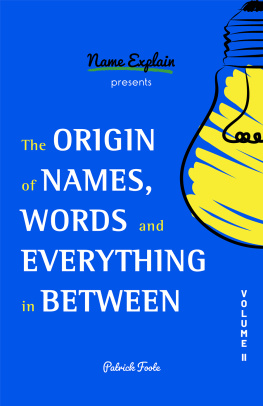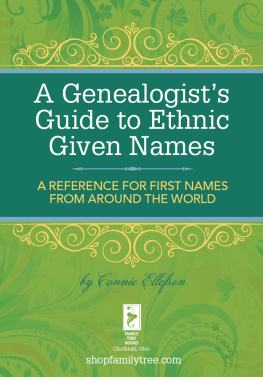
Copyright 2021 Patrick Foote
Published by Mango Publishing, a division of Mango Publishing Group,Inc.
Cover Design: Morgane Leoni
Art Direction: Morgane Leoni
Mango is an active supporter of authors rights to free speech and artistic expression in their books. The purpose of copyright is to encourage authors to produce exceptional works that enrich our culture and our open society.
Uploading or distributing photos, scans or any content from this book without prior permission is theft of the authors intellectual property. Please honor the authors work as you would your own. Thank you in advance for respecting our authors rights.
For permission requests, please contact the publisher at:
Mango Publishing Group
2850 Douglas Road, 2nd Floor
Coral Gables, FL 33134 U.S.A.
For special orders, quantity sales, course adoptions and corporate sales, please email the publisher at or +1.800.509.4887.
The Origins of Names, Words, and Everything in Between: Volume II
Library of Congress Cataloging-in-Publication number: 2021942638
ISBN: (print) 978-1-64250-681-5, (ebook) 978-1-64250-682-2
BISAC category code: LAN024000 LANGUAGE ARTS & DISCIPLINES / Linguistics / Etymology
Printed in the United States of America.
-02.jpg)

Con te nts
Well , here we are again . For lack of a better term and at the risk of sounding a tad too cheesy, the adventure continues! I hope you are all just as excited as myself to look into the origins of more names, words, and everything in between. Looking back at that first book feels like the tip of the iceberg, and, believe me, this is quite a big iceberg. Simply due to the fact that these books are all about uncovering how things got their names. Luckily for name nerds like myself and for the etymologically excitable like yourself, everything has a name.
So its time to dive back into the world of word origins yet again. Once again, I have found a plethora of names and words to share and explain to you all. Like last time, this book is split into themed sections, covering names that fit neatly into that section. From the most popular thing in that area, which you may have always wondered about, to how it got its name, to some lesser known but enjoyably named things. Im sure you understandthis is the sequel, after all, and who reads the sequel book first?! You have read the first book, havent you? Well, just in case theres anyone out there who is leaping into Volume II before reading Volume I, lets have a quick recap of things, shall we?
Wh o Am I?
The name of the person who wrote this book all about names is Patrick Footethats me, by the way, not quite sure why I wrote that in the third person. I have been studying etymology and word origins for roughly five years or so now. Though I must admit, when I say studying word origins, I dont mean studying them in some fancy library, at a well-respected university, or at some cushy educational job. I study word origins primarily in my basement or sometimes in a coffee shop if Im starting to scratch at the walls. As I study word origins for my YouTube channel Name Explain , which is all about pretty much what it sounds like, explaining names.
The channel had pretty humble beginnings; it started as something to do when I wasnt stacking the shelves of a supermarket during my day job. As the channel grew, I had to take risks, from leaving university where I was studying words to leaving the supermarket that paid my bills to leaving my parents and their home, which had always been a safety net for me. Yet those risks paid off as Name Explain is now one of the most popular YouTube channels focusing on etymology. It has allowed me to make uncovering etymologies my full-time job and even given me the chance to write these books, something that I am eternally grateful for. So while I may not have the academic credentials or a degree in the field, and I never claim to be a professional by any means, I do have a burning passion for word origins and plenty of experience googling answers, so youre in safe hands. At least, I think so anyway.
Wh at Is Etymology?
I have already used that big word a couple of times now, etymology. Its a word that came to us from the Greeks with their word etymologia , meaning to find the true origins of a word. Its basically a fancy word for word origins. But its one I love, so Ill be using it quite a lot in this book. Etymologies can come from a huge variety of places. As we just saw with the word etymology itself, words can come from ancient roots. Greek and Latin often play a large role, especially with the English language, so I have no doubts those languages will be popping up again in this book.
However, words can come to us through all kinds of etymologies. Some words are formed when we put other words together, like how the word armchair is just the words arm and chair put together. Sometimes, we use a whole string of words that become a mouthful to say every time, so we just take the first letter of each word and use that as a word unto itself. Like how the self-contained underwater breathing apparatus was shortened to just SCUBA. Sometimes words are named after people or places important to them, sometimes they have fun stories linked to them, and sometimes they are just made up out of thin air.
All etymologies are exciting in their own way, thats for sure. And while every word does have an etymology, sometimes, the passage of time, means, and lack of ancient information means we arent exactly sure what that etymology is. The greatest struggle of any etymologist is that the spoken word cant be preserved like a dinosaur bone or an ancient piece of pottery. Some of the greatest unsolved mysteries we have still are the unknown origins of words. But thats incredible unto itself. Take the word dog ; no one exactly knows where the word dog came from. Isnt it amazing that a word so commonplace as dog can also be equally mysterious?
Wh at Etymologies Are in This Book?
As mentioned, Volume I was the tip of the iceberg. With that book, I wanted to cover the big picture, obvious topics. If you were to ask someone to name things that have names, it would have been the topics of Volume I: countries, animals, towns, objects, planets, etc. While I could have easily found more entries on those same topics for this volume, this time, I went for completely new topics. Topics and themes from a huge variety of different fields, which I am sure you are already aware of, as youve probably seen the contents page by now. There are some less obvious topics covered this time around, thats for sure, but of course, everything has a name, so anything is up for covering, no matter how niche it may seem.
I also wanted to somewhat look at the other side of the coin in regard to the various subjects I covered last time. In Volume I, we looked at countries and cities on our planet today; this time around, we look into former, historic places that used to be on our globe. And we shone a huge spotlight on the animal kingdom last time around, so this time, lets shine a light on the plant kingdom instead and give the planets greenery the recognition it deserves. I still do cover some pretty obvious stuff in this book too. How did I fail to talk about bodies of water in the last book? And colours for that matter? Though perhaps most shocking is that in the last book, I failed to properly talk about the most commonplace names on our planet. The names of us! We all have names, and its these first names I want to talk about first.












-02.jpg)

